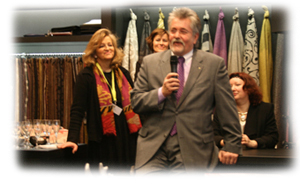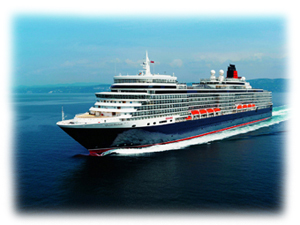
First Heimtextil Colombia scheduled for 2021
Opinion


This month sees the start of an exciting new monthly column on Innovation in Textiles called 'On the Floor'. Respected technical textiles journalist Adrian Wilson (right) will be bringing readers news and his views directly from the floor of the industry’s leading exhibitions and conferences around the world.. January 2011, Frankfurt - Contract business is back, which is great news for European manufacturers of upmarket fabrics, as well as their fibre suppliers. In fact, business as a whole i

23rd January 2011
Adrian Wilson
|
Frankfurt
This month sees the start of an exciting new monthly column on Innovation in Textiles called 'On the Floor'. Respected technical textiles journalist Adrian Wilson will be bringing readers news and his views directly from the floor of the industry’s leading exhibitions and conferences around the world.
Contract business is back, which is great news for European manufacturers of upmarket fabrics, as well as their fibre suppliers. In fact, business as a whole in the home furnishings market is currently buoyant, and both exhibitors and visitors were up at the 2011 Heimtextil show held in Frankfurt from January 12-15th.
In a large part, Heimtextil is a commodity trading show, as illustrated by the fact that three of the Messe Frankfurt halls were fully devoted to fabrics for bedding, bathroom and tablewear from Asia – Asian Vision, Asian Selection and Asian Feeling.
In fact, of the total of 2601 exhibitors from 60 countries at the show, 87% were from outside Germany, with China, India and Pakistan inevitably leading the field from Asia, and Turkey strongly represented due to its proximity to the European market.
While all in the Asian halls seemed deliriously busy, for any form of textile technology innovation it was really necessary to look elsewhere.
The home textiles market, like that of technical textiles, is still significant for many European textile manufacturers, for whom the manufacture of commodity products is no longer an option. And the contract furnishings market – for significant leisure projects such as hotels and cruise ships – is crucial to this.
Austria’s Baumann has successfully supplied furnishing fabrics for more than 500 cruise ship projects over the past decade, supplying the material for sofas, chairs, bedspreads and curtains in more than 20,000 cabins. It has also worked with design companies on a wide range of exclusive hotels.
 Contract furnishings
Contract furnishings“Quite simply, the major contractors will pay a proper price for quality and reliability, and this is to the benefit of everyone,” said the company’s chief technology officer Maximilian Baumann in Frankfurt.
In its latest success story, Baumann has secured the contract to supply fabrics for the cabins and public areas of the new Princess Cruises und Cunard Queen Elizabeth luxury liner.
Austria’s tiny textile industry has a second leader in the contract furnishings field too, in Backhausen, which among other collections showcased its Returnity programme for 100% recycled flame retardant fabrics made from Trevira CS at Heimtextil.
Contract business is equally important to the remaining European fibre producers like Trevira, and increasing safety requirements and stringency in legislation in respect of flame retardancy have seen Trevira CS become almost standard in contract fabrics.
There are now over 200 different Trevira CS fibre types, and in terms of appearance it is frequently not possible to distinguish the fabrics produced from those employing natural fibres. Today there are in excess of 1000 collections and over 5000 designs in Trevira CS.
Trevira reports that there are currently around 700 new hotels in the planning stage in Europe and in excess of 3000 projects in the pipeline in the USA too. Hotel growth in the Middle East, meanwhile, is around 12% annually.
 As far as cruise ships are concerned, the Disney Dream – the largest cruise ship ever built in Germany, with room for 4000 passengers – was completed in November last year, and there are a total of 20 further cruise liner projects currently in development which will feature Trevira CS fabrics.
As far as cruise ships are concerned, the Disney Dream – the largest cruise ship ever built in Germany, with room for 4000 passengers – was completed in November last year, and there are a total of 20 further cruise liner projects currently in development which will feature Trevira CS fabrics.
These include the Queen Elizabeth luxury liner, which is being built for Princess Cruises und Cunard, and for which Baumann has secured the contract to supply fabrics for the cabins and public areas, with a heavy emphasis on Trevira CS.
With 1029 cabins, the Queen Elizabeth is 294 metres long and 32 metres wide and can hold up to 2,058 passengers.
In total, Baumann will be supplying some 17,000 metres of fabric, 8,500 metres of which will be the floral jacquard for seating in the standard cabins, with other specialised materials to be supplied for the theatre and the grand ball room.
Trevira’s latest innovation, meanwhile, is the introduction of fibres from Ingeo biopolymer, initially for nonwovens, but with the aim of eventually introducing variants for weaving and knitting. It will be interesting to see how rapidly these can be developed to meet the stringent demands of the contract business.
That’s all for this month. In my next column, I’ll be reporting from ISPO in Munich, on developments from the outdoor and winter sports sector.
![]()

Business intelligence for the fibre, textiles and apparel industries: technologies, innovations, markets, investments, trade policy, sourcing, strategy...
Find out more